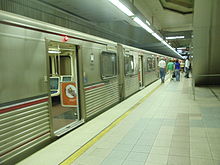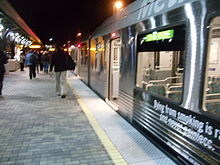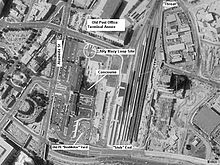Union Station (Los Angeles)
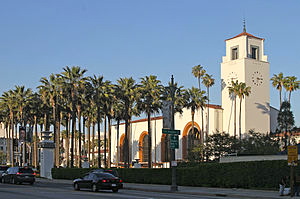
Metrolink – Union Station, Los Angeles – Historic Footage
Historical footage of Union Station, Los Angeles, California, produced by Southern California Regional Rail Authority (Metrolink) in the early 1990’s.
Complex architecture of the main building and gardens
Los Angeles Union Station (or LAUS) is the main railway station in Los Angeles, California. In recent years the station has become a major transportation hub for Southern California serving 60,000 passengers a day as they access Amtrak long distance trains, Amtrak California regional trains, Metrolink commuter trains and several Metro Rail subway and light rail lines. The Patsaouras Transit Plaza on the east side of the station serves dozens of bus lines operated by Metro and several other municipal carriers.
The station opened in May 1939 as the Los Angeles Union Passenger Terminal, replacing the older La Grande Station and Central Station. One of a number of union stations built in the early 1900s it served trains from the Union Pacific, Santa Fe and Southern Pacific Railways. Built on a grand scale, Union Station became known as “Last of the Great Railway Stations” built in the United States. It was placed on the National Register of Historic Places in 1980.
Architecture
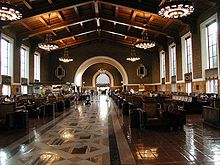 The waiting room at the Los Angeles Union Station
The waiting room at the Los Angeles Union Station
Union Station was partially designed byJohn Parkinson and Donald B. Parkinson (the Parkinsons) who had also designed Los Angeles City Hall and other landmark Los Angeles buildings. They were assisted by a group of supporting architects, including Jan van der Linden. The structure combines Dutch Colonial Revival architecture (the suggestion of the Dutch-born Jan von der Linden), Mission Revival, and Streamline Moderne style, with architectural details such as eight-pointed stars.
Enclosed garden patios are on either side of the waiting room, and passengers exiting the trains were originally directed through the southern garden. The lower part of the interior walls is covered in travertine marble, and the upper part is covered with an early form of acoustical tile. The floor in the large rooms is terra cotta tile with a central strip of inlaid marble (including travertine, somewhat unusual in floors since it is soft).
Attached to the main building to the south is the station restaurant (the last of the “Harvey House” restaurants to be constructed as a part of a passenger terminal) designed by southwestern architect Mary Colter. Although now usually padlocked and stripped of many interior furnishings, the topology of its rounded central counter, streamlined booths, and inlaid floor patterns remain.
Even with its grand scale it is considered small in comparison to other union stations.
History
In 1926, a measure was placed on the ballot giving Los Angeles voters the choice between the construction of a vast network of elevated railways or the construction of a much smaller Union Station to consolidate different railroad terminals. The election would take on racial connotations and become a defining moment in the development of Los Angeles. The proposed Union Station was located in the heart of what was Los Angeles’ original Chinatown. Reflecting the prejudice of the era, the conservative Los Angeles Times, a lead opponent of elevated railways, argued in editorials that Union Station would not be built in the “midst of Chinatown” but rather would “forever do away with Chinatown and its environs.” Voters approved demolishing much of Chinatown to build Union Station by a narrow 51 to 48 percent.
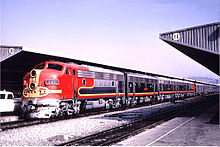 The Atchison, Topeka and Santa Fe Railway‘s combined Super Chief/El Capitan at the station in 1966.
The Atchison, Topeka and Santa Fe Railway‘s combined Super Chief/El Capitan at the station in 1966.
The station took over service from La Grande Station and Central Station and originally served the Atchison, Topeka and Santa Fe Railway, Southern Pacific Railroad, and Union Pacific Railroad, as well as the Pacific Electric Railway and Los Angeles Railway (LARy). It saw heavy use during World War II, but later saw declining patronage due to the growing popularity of air travel and automobiles.
The station was placed on the National Register of Historic Places in 1980 and was designated as Los Angeles Historic–Cultural Monument No. 101 on August 2, 1972.
The Ventura County Line, the Antelope Valley Line and the San Bernardino Lineopened in 1992 in part, completely to San Bernardino by 1993, with the Orange County Line opening in 1994. The RedLine (including what is now the Purple Line) and the Riverside Line began operation from the station the following year. The Blue Line which opened in 1990 was originally intended to terminate at Union Station but currently terminates at 7th Street/Metro. The Gold Line began operating in 2003.
In February 2011, the Metro Board approved the purchase of Union Station from Catellus/Prologis for $75 million. The deal was closed on April 14, 2011.
The station was formerly designated the ‘Los Angeles Union Passenger Terminal’ (LAUPT), but its former owner, Catellus Development, officially changed the name to Los Angeles Union Station.


